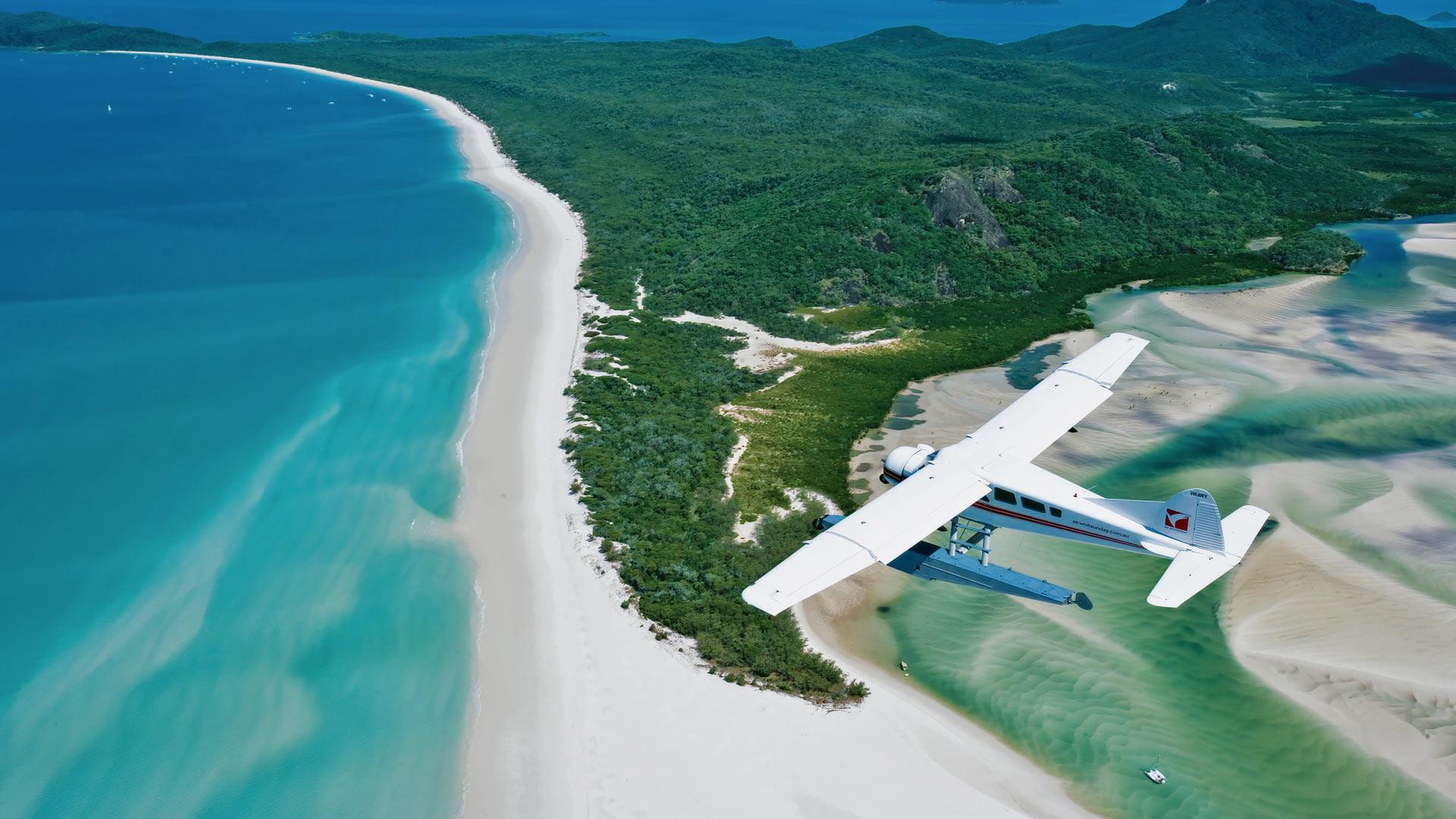Whitehaven Beach, locate in the heart of the Great Barrier Reef on Whitsunday Island, Queensland, Australia, is often hailed as one of the world’s most beautiful beaches. Known for its pristine white silica sand, crystal-clear turquoise waters, and lush tropical surroundings, Whitehaven Beach is a destination that promises an unforgettable experience. This article provides a comprehensive look at Whitehaven Beach, covering its geological significance, natural beauty, activities, conservation efforts, and travel tips.

Geological Significance
Whitehaven Beach stretches over seven kilometers and is renown for its 98% pure silica sand, which gives the beach its stunningly bright white color. Unlike regular beach sand, silica sand doesn’t retain heat, making it comfortable to walk on even on the hottest days. The origins of this unique sand remain a subject of scientific curiosity. It’s believe to have been carried to the beach over millions of years by prevailing sea currents. The silica’s fine grain and unique properties contribute to the beach’s almost surreal appearance, attracting geologists and tourists alike.
Natural Beauty
The beach is situated on Whitsunday Island, the largest of the 74 islands in the Whitsunday group. The island itself is part of the Whitsunday Islands National Park and the Great Barrier Reef World Heritage Area. The landscape is characterized by lush rainforests, diverse wildlife, and vibrant coral reefs, making it a paradise for nature lovers. The contrasting colors of the white sand, the azure waters, and the green foliage create a picturesque setting that has been widely photographed and celebrated.
Activities and Attractions
Whitehaven Beach offers a variety of activities that cater to all types of travelers. Whether you are seeking adventure, relaxation, or an educational experience, Whitehaven Beach has something to offer.
Swimming and Sunbathing
The warm, calm waters of Whitehaven Beach are perfect for swimming and snorkeling. The gentle waves and shallow areas make it a safe environment for families with children. The beach’s vast expanse ensures that even during peak tourist seasons, there is plenty of space for everyone to enjoy.
Hill Inlet
At the northern end of Whitehaven Beach is Hill Inlet, a stunning tidal estuary. The shifting tides create a swirling fusion of colors as the white silica sand and turquoise waters blend. Hill Inlet is best view from Tongue Point, which offers panoramic views of this natural wonder. Many tours include a visit to this lookout, and the short hike to the viewpoint is reward with breathtaking scenery.
Snorkeling and Diving
The surrounding coral reefs are part of the Great Barrier Reef, home to an incredible variety of marine life. Snorkeling and diving tours allow visitors to explore the underwater world, where they can see vibrant coral formations, tropical fish, and other marine creatures. The clear waters provide excellent visibility, making it a diver’s paradise.
Eco-Tours and Wildlife
Guided eco-tours provide insights into the island’s flora, fauna, and conservation efforts. The Whitsunday Islands are home to a range of wildlife, including sea turtles, dolphins, and an array of bird species. These tours are educational and promote awareness about the importance of preserving this unique ecosystem.
Conservation Efforts
Whitehaven Beach is part of the Whitsunday Islands National Park, and significant efforts are make to preserve its natural beauty. The beach is meticulously maintain, with strict regulations on littering and waste disposal. The Queensland Parks and Wildlife Service, along with various non-profit organizations, work tirelessly to ensure that the beach and its surrounding environments remain pristine.
Tourism operators also play a crucial role in conservation. Many tour companies follow eco-friendly practices, such as reducing plastic use, promoting sustainable tourism, and educating visitors about the local environment. The combined efforts of these organizations help protect Whitehaven Beach from the adverse effects of tourism.
Travel Tips
Visiting Whitehaven Beach requires some planning, especially for international travelers. Here are some tips to help make your trip enjoyable and hassle-free.
Getting There
Whitehaven Beach is accessible by boat, seaplane, or helicopter from Airlie Beach, Hamilton Island, and other nearby locations. Boat tours are the most popular option and range from half-day to full-day excursions. Seaplane and helicopter tours offer a unique perspective of the island and are ideal for those looking to add an extra touch of adventure to their visit.
Best Time to Visit
The best time to visit Whitehaven Beach is during the dry season, which runs from May to November. During this period, the weather is warm and sunny, with lower humidity and minimal rainfall. The wet season, from December to April, can bring heavy rains and strong winds, which may affect travel plans.
What to Bring
When visiting Whitehaven Beach, it’s essential to pack the following items:
- Sunscreen: The Australian sun can be intense, so a high-SPF sunscreen is a must.
- Hat and Sunglasses: To protect yourself from the sun.
- Swimwear and Towel: For swimming and relaxing on the beach.
- Water and Snacks: There are no facilities on the beach, so it’s important to bring enough water and snacks for the duration of your stay.
- Camera: To capture the stunning scenery.
Conclusion
Whitehaven Beach is more than just a beautiful location; it is a testament to nature ability to create breathtaking wonders. Its pristine white sands, clear turquoise waters, and lush surroundings make it a must-visit destination for anyone traveling to Australia. Whether you are looking to relax on the beach, explore the underwater world, or learn about conservation efforts, Whitehaven Beach offers an experience that is both enriching and unforgettable. With proper planning and respect for the environment, visitors can enjoy all that this tropical paradise has to offer while contributing to its preservation for future generations.



